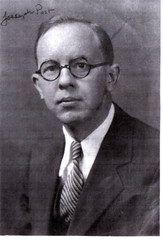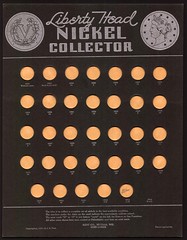
PREV ARTICLE
NEXT ARTICLE
FULL ISSUE
PREV FULL ISSUE
J.K. POST AND R.S. YEOMAN'S ROLES IN THE DEVELOPMENT OF THE COIN BOARDLast week James Higby wrote: The E-sylum article on the Guide Book to the Redbook jostled my memory enough to go back through my favorites to find this article by Ed Reiter about R. S. Yeoman. David Lange submitted the following on the evolution and marketing of coin boards, based on research for his recent book, 'Coin Collecting Boards of the 1930s & 1940s: A Complete History, Catalog and Value Guide. David also supplied image of J. K. Post and one of his coin boards. -Editor  I could not let this fantastic account go unchallenged. Ed Reiter's article telling of Richard Yeo's mastery of the coin board was based almost entirely on the old (Racine) Whitman's self-serving rewrite of the history behind the development and marketing of coin boards. Of course, this was the only source of information available to Ed at the time. Coin board inventor and promoter Joseph K. Post died prematurely in 1943, and the true story of coin boards was by then already being suppressed by Whitman's marketing people. I could not let this fantastic account go unchallenged. Ed Reiter's article telling of Richard Yeo's mastery of the coin board was based almost entirely on the old (Racine) Whitman's self-serving rewrite of the history behind the development and marketing of coin boards. Of course, this was the only source of information available to Ed at the time. Coin board inventor and promoter Joseph K. Post died prematurely in 1943, and the true story of coin boards was by then already being suppressed by Whitman's marketing people.The research I performed for my book on coin boards revealed that not only did Post invent this product, but that he also devised its marketing plan and the key selling points that made the collecting of coins from circulation the powerhouse hobby that it was in the years 1935-65.  Richard Yeo (later to adopt the pen name R. S. Yeoman) was given the task of expanding and marketing the line of coin boards only after Post sold his rights (on a provisional basis) to Whitman, effective October 1, 1935. Post had already developed an extensive mailing list which, though largely limited to the Midwest, was remarkably broad in its variety of wholesale and retail businesses. Least often seen on this list (which survives and was partly reproduced in my book) were coin dealerships, as most established dealers sniffed at the notion of collecting coins from circulation and considered such activity entirely unrelated to the numismatic trade. Richard Yeo (later to adopt the pen name R. S. Yeoman) was given the task of expanding and marketing the line of coin boards only after Post sold his rights (on a provisional basis) to Whitman, effective October 1, 1935. Post had already developed an extensive mailing list which, though largely limited to the Midwest, was remarkably broad in its variety of wholesale and retail businesses. Least often seen on this list (which survives and was partly reproduced in my book) were coin dealerships, as most established dealers sniffed at the notion of collecting coins from circulation and considered such activity entirely unrelated to the numismatic trade.Post saw the real appeal of coin boards as something for the novice, the would-be treasure hunter. That's why he focused his sales on non-numismatic retail establishments such as stationery stores, 5-and-10 cent stores, newsstands and the like. These are the same sort of places that were still selling coin folders during my early collecting years in the mid 1960s. Yeo expanded this same marketing, though with Whitman's already established distribution outlets for its other novelties, games and children's books he was destined to have far greater success than Post could achieve while holding down his unrelated, full-time job with Kimberly-Clark Corporation. The other issue which was long accepted as gospel (because the old Whitman was the only source of information) was that Yeo and Whitman invented the coin folder. They most certainly did not, and Whitman was not even the first company to react to this unwelcome development. The coin folder seems to have been devised and first sold by the Daniel Stamp Company (DANSCO) of Los Angeles in 1939 or early 1940. By the middle of 1940, Whitman's closest rival in the board business, Joseph Oberwise & Company of Los Angeles, introduced its own line of folders. It did this after first attempting to compete by modifying its coin boards with scoring lines for users to fold them in half themselves, a concept which was not successful. Though copyright dated 1940, the first Whitman coin folders did not appear until early the following year, and they were introduced in order to compete with similar products by Dansco and Oberwise that had already begun to steal market share. What really put Whitman over the top in this competition was its superior contacts and marketing reach, combined with a genuinely superior product. Its line of folders was not only more attractive (with their familiar silver on blue covers) but also was expanded over the next few years to include titles not offered by other publishers. Only the Shore Line brand, introduced in 1963, had a greater range of titles for American coins, though Whitman still held an edge in world titles. The fact that most of these exotic titles were poor sellers and still survive today as unsold remainders did not diminish the company's prestige among coin collectors and dealers, the latter finally accepting that boards and folders were indeed good for expanding the number of collectors. Richard Yeo was still a very successful and prominent figure in the hobby, but simply not as the inventor or promoter of coin boards. His real achievement was in devising and marketing (with help from others) the Blue Book, the Red Book and various other publications which became hobby staples for many years. He also took a sincere, hands-on role within numismatics that gave him great credibility with hobby figures, and he put together an excellent team of writers, researchers and marketing people who collectively made Whitman hum for decades. He didn't live to see Western Publishing Company (parent of the Whitman Coin Products division) run this finely-tuned machine into the ground in the 1990s, and I imagine it would have hurt him as much as it did others who loved the company and what it meant to the hobby. Fortunately, the Whitman name and much of its product line survives today under good management in Atlanta. Wayne Homren, Editor The Numismatic Bibliomania Society is a non-profit organization promoting numismatic literature. See our web site at coinbooks.org. To submit items for publication in The E-Sylum, write to the Editor at this address: whomren@gmail.com To subscribe go to: https://my.binhost.com/lists/listinfo/esylum All Rights Reserved. NBS Home Page Contact the NBS webmaster 
|